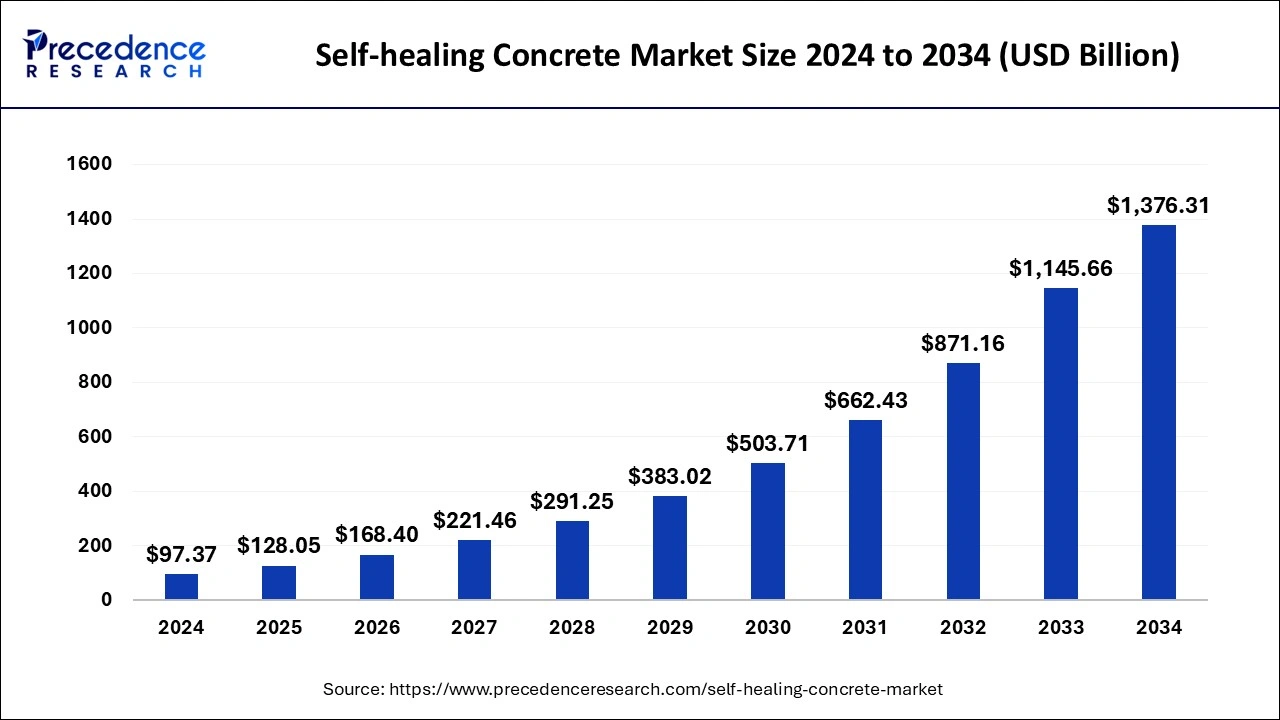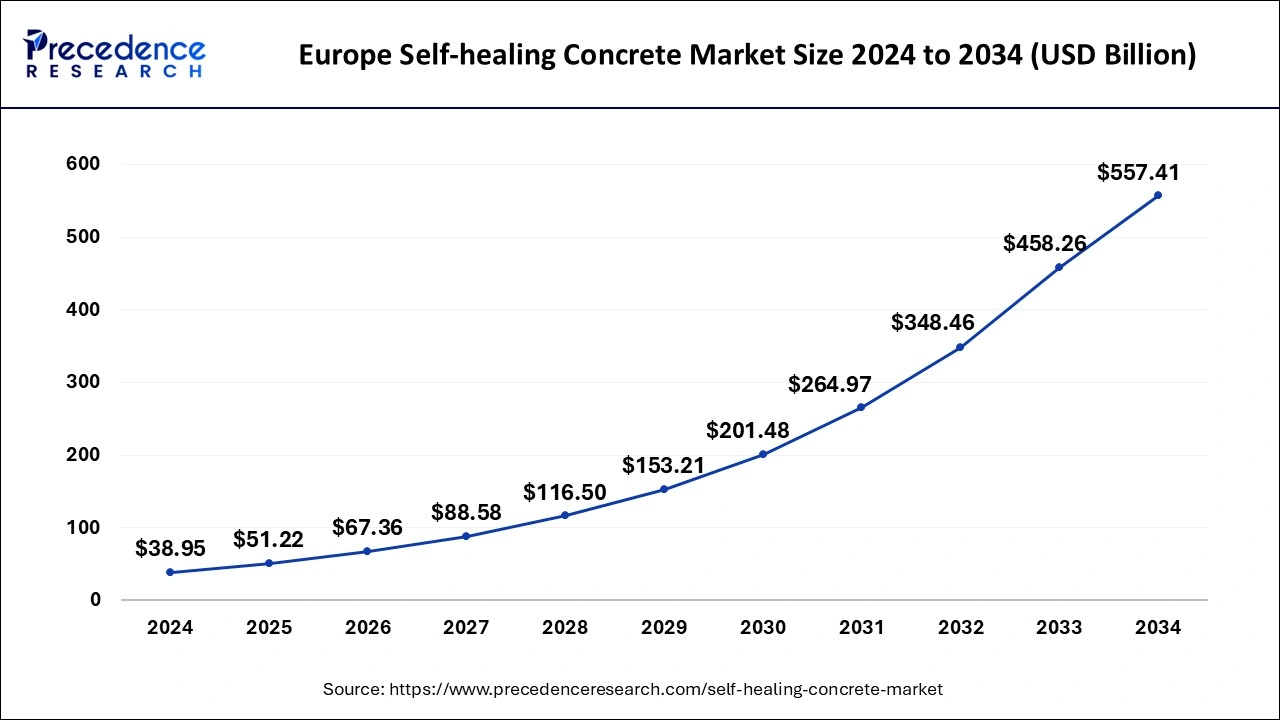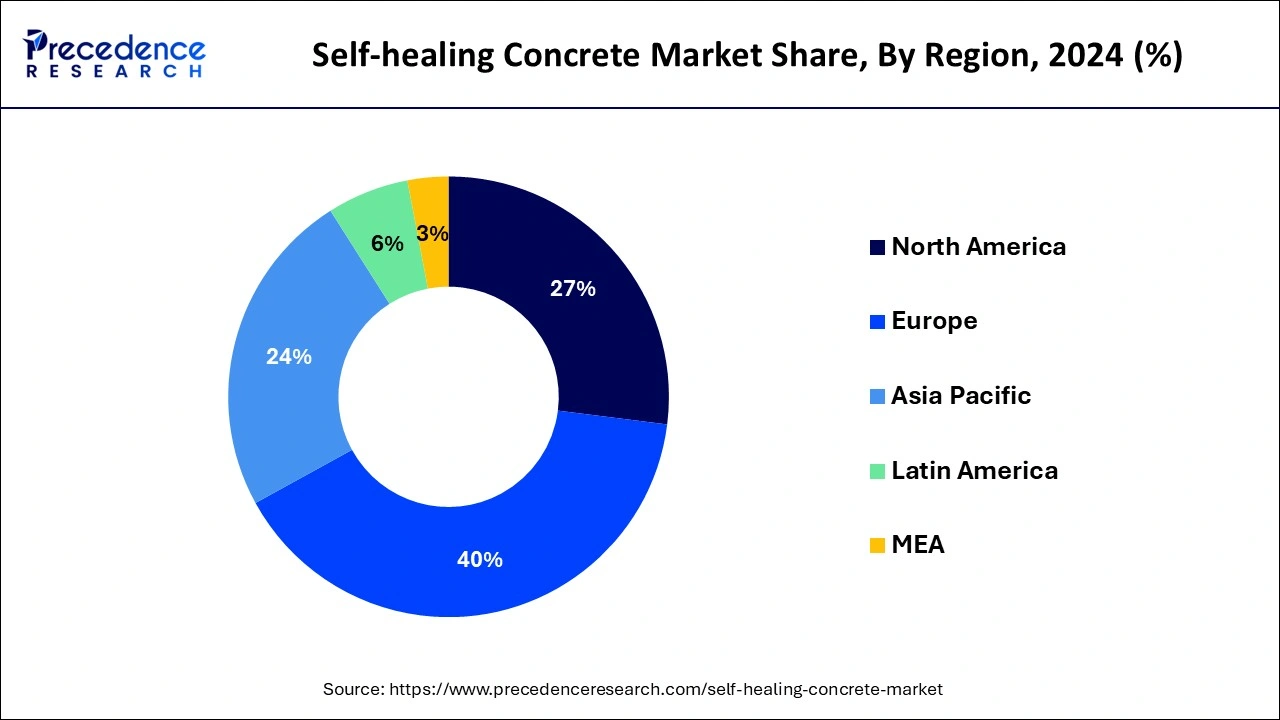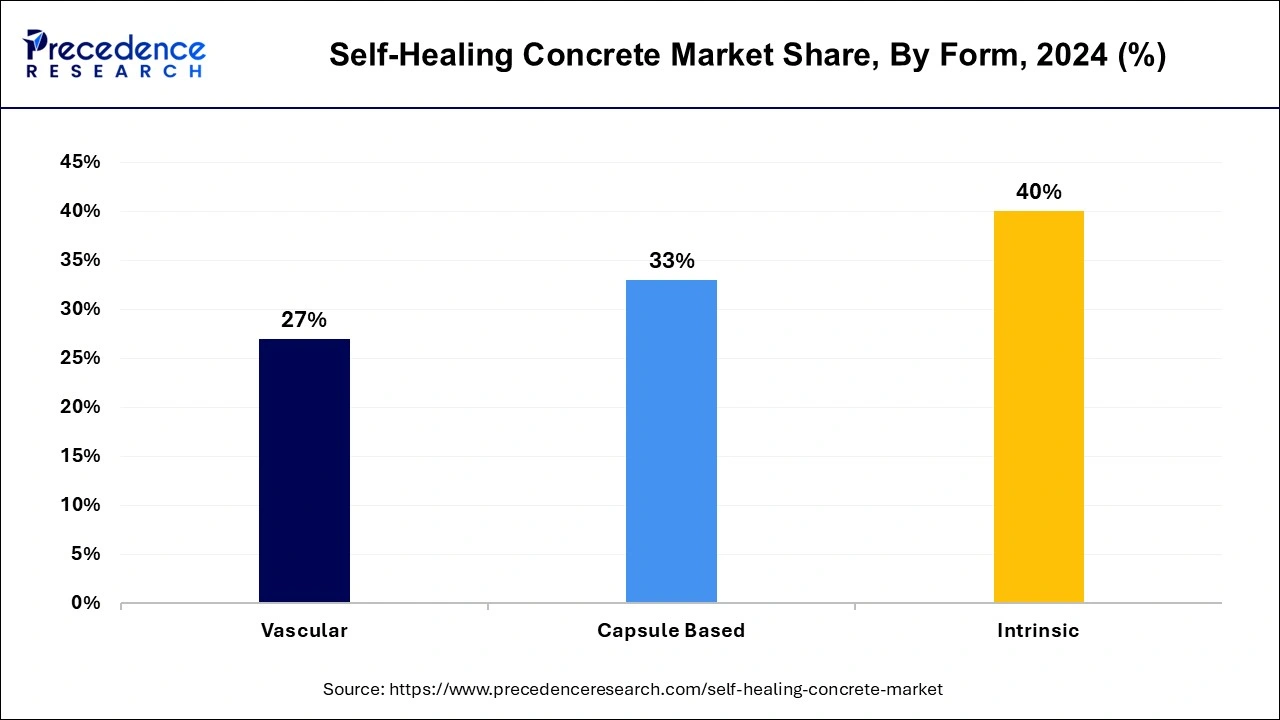List of Contents
Self-healing Concrete Market Size and Growth 2025 to 2034
The global self-healing concrete market size was estimated at USD 97.37 billion in 2024 and is predicted to increase from USD 128.05 billion in 2025 to approximately USD 1376.31 billion by 2034, expanding at a CAGR of 30.33% from 2025 to 2034. The primary reasons behind the growth of this market are a rise in the construction industry and a need for sustainable solutions for build-ing various structures.

Self-healing Concrete Market Key Takeaways
- Europe dominated the market with the largest market share of 40% in 2024.
- North America is expected to grow significantly in the global market.
- By form, the intrinsic segment accounted for the highest revenue share of 40% in 2024.
- By form, the capsule based segment is expected to grow at a significant rate during the forecast period.
- By application, the infrastructure application segment dominated the market in 2024.
- By application, the industrial segment is projected to expand rapidly in the upcoming years.
EuropeSelf-healing Concrete Market Size and Growth 2025 to 2034
The Europe self-healing concrete market size was exhibited at USD 38.95 billion in 2024 and is predicted to be worth around USD 557.41 billion by 2034 at a CAGR of 51.22% from 2025 to 2034.

Europe dominated the self-healing concrete market in 2024. This was pri-marily because of a rising consumer demand. Manufacturers are working towards in-creasing the production efficiency and improve the concrete quality. Self-healing con-crete is a sustainable alternative and can reduce greenhouse gas emissions. Because of advancements in self-healing concrete, manufacturers can also customize the con-crete products according to the construction requirements. Hence, there is a wide range of self-healing concrete solutions offered by the manufacturers, and this leads to rising competition in the market.

North America is expected to grow significantly in the global self-healing concrete market. There is an increase in building construction, and more people are becoming aware of better qualities offered by self-healing concrete over normal con-crete. Investments in infrastructure development have increased, and this has caused construction activities to rise, and hence, more opportunities are created for the mar-ket. Self-healing concrete is used to construct several structures, such as single- and double-story extensions, septic tanks, garden sheds, walls, vehicle parking, etc.
Market Overview
Concrete is a material used in the construction of houses and buildings. Concrete can develop cracks in the surface because it has poor tensile strength as compared to other building materials. Small cracks can affect the durability of the structure. These cracks might keep expanding and damage the structure. Hence, it is important to fix these cracks. Self-healing concrete is concrete that can fix its cracks autonomously. The self-healing concrete market makes the structure more durable and ensures that the product provides a prolonged period of service. Self-healing concrete is also envi-ronment-friendly.
The concept of self-healing in concrete is old and well-known. It contains innate heal-ing properties. Over time, the cracks in concrete get healed by the hydration of clinker minerals or by carbonation of calcium hydroxide. This type of healing is only possible in the presence of water, and hence, it can be difficult to achieve in areas with water scarcity. Concrete can be altered to have the properties of self-healing the cracks. In the self-healing concrete market, to improve the self-healing capability, admixtures, minerals, and superabsorbent polymers can be added. The concrete can also be modi-fied to have a built-in quality of self-healing.
Self-healing Concrete Market Growth Factors
- There is a surge in the construction industry due to the ongoing developments in the self-healing concrete market.
- Self-healing concrete can heal its cracks, requires low maintenance, and is superior to traditional concrete. This gives the self-healing concrete market an edge over more traditional alternatives.
- Advanced solutions in the self-healing concrete market uses hydrogels and microor-ganisms to repair the cracks in the concrete.
Market Scope
| Report Coverage | Details |
| Growth Rate from 2025 to 2034 | CAGR of 30.33% |
| Market Size in 2025 | USD 128.05 Billion |
| Market Size by 2034 | USD 1376.31 Billion |
| Largest Market | Europe |
| Base Year | 2024 |
| Forecast Period | 2025 to 2034 |
| Segments Covered | By Form and By Application |
| Regions Covered | North America, Europe, Asia-Pacific, Latin America, and Middle East & Africa |
Market Dynamics
Drivers
Research and development
The primary driver of self-healing concrete is that it can heal its cracks. The self-healing concrete market saves a lot of money that could have otherwise been spent on renovating the concrete. In concrete where steel reinforcement is used, corrosion takes place, and this leads to further damage to the concrete. Traditional concrete cracks, when filled with water, fix the cracks as the cement binds with water, and the cracks get ‘healed.' There has been constant research to take the healing properties of concrete a step further by using hydrogels, microorganisms that precipitate calcium carbonate, or encapsulated polymers that can break open during cracking, releasing their content and filling the crack.
Restraint
High cost and a required expertise
Compared to normal concrete, self-healing concrete is more expensive, and the prices might be 10-30% higher. Self-healing concrete is quite new, and hence, there is a need for more experts who can install and handle the concrete. There is a limitation of the environment when using self-healing concrete, and not all self-healing concrete is suitable for different environments. There are still ongoing developments in improv-ing the quality of self-healing concrete. Bacteria and microcapsules are used in the self-healing concrete market, and there might be issues with their disposal after their life is over.
Opportunity
Booming construction and transport
Concrete is one of the most important components while building a house. As the self-healing concrete market continues to grow, there will be more opportunities for advancements in the construction industry. Houses with greater strength and durabil-ity will be constructed. Alongside, the government will boost the construction of bridges, tunnels, highways, etc.
Self-healing concrete is durable, and hence, maintenance costs are reduced when the structures constructed have an extended lifespan. Self-healing concrete is also a green and environment-friendly solution because it has a long life. The self-healing concrete market will expand further as these constructions gain pace. Governments also have initiatives to provide houses to poor people at low costs. As these initiatives gain pace, they will help the market grow.
Form Insights
The intrinsic segment accounted for the the self-healing concrete market in 2024. It will continue to witness a high growth rate during the forecast pe-riod. In vascular form, a series of tubes are filled with concrete healing substances, and these are passed through concrete structures to the exterior part of buildings from the interior. In this system, the tubes are placed in locations where cracks are likely to happen. In this type of concrete, healing substances can constantly be sup-plied to the areas of cracks if needed. Hence, it can cover a wider area of the crack.

In the self-healing concrete market, the capsule based segment is expected to grow at a significant rate during the forecast period. In capsule-based self-healing concrete, there are capsules filled with self-healing material. If a crack appears, these capsules get ruptured, and their self-healing material is released, helping to heal the crack. High precision is required to make these capsules. They are made such that they can handle the pressure of concrete but are fragile enough to break when there is dam-age. Capsule-based self-healing concrete has the advantage that the capsules are evenly distributed, and hence, they cover the entire concrete and help in healing.
Application Insights
According to application, the infrastructure application segment dominated the self-healing concrete market in 2024. There is a rise in construction. People are earning good disposable incomes and planning to build their own houses. Governments are introducing new initiatives and policies to provide houses to poor people, such as the ‘aawas yojna' in India. Transport is being made more convenient with the construc-tion of high-quality roads, bridges, railway stations, airports, etc., which helps in in-creasing connectivity. Power stations and dams, too, are important and require high-quality concrete to bear big shocks and mechanical impacts. The infrastructure sector is useful for driving the economy in any country as the country presents itself in front of the world.
In the self-healing concrete market, the industrial segment is projected to expand rap-idly in the upcoming years. Industries are important for manufacturing or processing the raw materials. There is a surge in several types of industries like automobiles, software, plastics, food processing, dairy, and many more. Industries need high-quality processing units, and in such places, companies cannot afford a high level of damage to the concrete structures. Self-healing concrete requires very low mainte-nance, and hence, they are ideal for industrial uses.
Self-healing Concrete Market Companies
- Basilisk
- PENETRON
- Kryton
- Xypex Chemical Corporation
- Sika AG
- BASF SE
- Hycrete, Inc.
- Cemex
- Oscrete
- GCP Applied Technologies
- RPM International
Recent Developments
- In December 2023, Drexel University's College of Engineering came up with research to give concrete the properties of tissue healing, where the concrete healing bacteria will rush to the site of cracks and repair the damage. A strain of the bacteria Lysini-bacillus sphaericus will be the healing agent. The bacteria is found in soil and is able to drive a process of microbial-induced calcium carbonate precipitation. From this process, it creates a stone-like material that can harden and stabilize, thereby sealing the exposed cracks.
Segments Covered in the Report
By Form
- Intrinsic
- Capsule Based
- Vascular
By Application
- Residential
- Industrial
- Commercial
- Infrastructure
By Geography
- North America
- Asia Pacific
- Europe
- Latin America
- Middle East & Africa
For inquiries regarding discounts, bulk purchases, or customization requests, please contact us at sales@precedenceresearch.com
Frequently Asked Questions
Ask For Sample
No cookie-cutter, only authentic analysis – take the 1st step to become a Precedence Research client